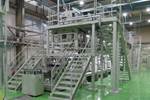CARBOWAVE studies microwave and plasma-induced carbonization for carbon fiber production
The European research consortium is holistically exploring the process’ improvement and commercialization for more energy-efficient, affordable materials manufacturing.
Stabilization furnace for the oxidation of PAN fibers. Source | DITF
The (DITF), as part of the European CARBOWAVE research consortium, highlights a novel technology using microwaves and plasma heating to produce carbon fibers in an energy-efficient manner, which also results in more affordable production.
Carbon fiber production is complex and energy-intensive. Stabilization and carbonization of the fibers, which are often made from petroleum-based polyacrylonitrile (PAN), requires slow process control in high-temperature furnaces. Despite the considerable energy input, a low material yield is achieved due to the long dwell time in the ovens.
CARBOWAVE’s solution replaces the stabilization and carbonization process. Energy is only induced into the fibers locally, thereby minimizing energy loss. This process also shortens the production time of carbon fibers, enabling higher production volumes with lower energy consumption.
Read “CARBOWAVE project finds alternative to PAN conversion with up to 70% less energy consumption”
Their specific research objectives are to develop an optimal coating for PAN fibers that improves microwave adsorption, to develop a plasma heating system for the oxidative stabilization of PAN fibers and to advance microwave and plasma technology for continuous processes.
The DITF is responsible for implementing these processes in continuous production and on pilot lines in a pilot plant. The DITF’s central task is the stabilization of the precursor fibers with plasma technology. This involves combining plasma and low-pressure technology to reduce energy consumption in the stabilization process.
The CARBOWAVE project includes recycling of carbon fibers. Partners believe that the new process will also enable microwave-assisted decomposition of carbon fiber composites.
Related Content
-
Plant tour: Teijin Carbon America Inc., Greenwood, S.C., U.S.
In 2018, Teijin broke ground on a facility that is reportedly the largest capacity carbon fiber line currently in existence. The line has been fully functional for nearly two years and has plenty of room for expansion.
-
The potential for thermoplastic composite nacelles
Collins Aerospace draws on global team, decades of experience to demonstrate large, curved AFP and welded structures for the next generation of aircraft.
-
Combining multifunctional thermoplastic composites, additive manufacturing for next-gen airframe structures
The DOMMINIO project combines AFP with 3D printed gyroid cores, embedded SHM sensors and smart materials for induction-driven disassembly of parts at end of life.



